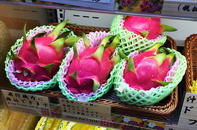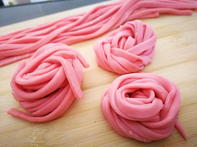The large scaly fruits of the dragon plant are a hugely popular fruit in Asia, rating under the top-5 fruits, after fruits like lychee and banana. Also known as pitaya, it is revered for its shape and colour in China.

These healthy, low-energy fruits are versatile and nutritious, are easy to peel and are excellent eaten fresh, slightly chilled.
Producers such as Amorentia Estate & Nursery in Limpopo are embarking on a process of educating retailers and consumers about the benefits of dragon fruit from South Africa.
Uses of Dragon Fruit

Dragon fruit is primarily grown for the fresh eating market and is often sold at farmers' markets in South Africa. The fruit also can also be processed into many value-added products such as dried fruit rolls, fruit bars, ice cream, jams, juices, pastries, as fruit pulp and in yoghurt. The juice of the red varieties can also be used as a natural dye. Herbal teas, water and vodka are also infused with the flavour of dragon fruit and the fruit may be used to make wine.
The unopened flower bud can be cooked and eaten as a vegetable and the flowers can be steeped in boiling water and enjoyed as a tea. The plant is widely used as an ornamental plant in gardens and used as a climber to disguise fences.
The University of Pretoria is doing research on the use of dragon fruit extracts in cosmetics. It was found that the dragon fruit juice may have similar properties as that of Aloe ferox and Aloe vera and maybe even 10 times more. Properties of dragon fruit extract include moisturising, anti-ageing, skin firming and stimulation of collagen synthesis.
The skin of the dragon fruit makes up to 22% of the total fruit weight, yet this is mostly discarded. Dragon fruit peel contains very valuable nutrients such as anthocyanins - a potent antioxidant. Dragon fruit peel can be used for a variety of purposes: cut into thin strips and fried in sesame oil or used to prepare teas. Dragon fruit skin powder has been tested in trials and it was found that it can influence the blood fat levels in mice. In the Philippines, the powder was used to make pink noodles.
Benefits of Dragon Fruit
The health benefits of dragon fruit are due to its antioxidant, antibacterial and nutritional properties, helping to boost immunity, due to high levels of vitamin C, speed up metabolism and the digestive process. Oligosaccharides, present in dragon fruit, may help stimulate probiotic bacteria in the stomach and intestines.
Fibre-rich dragon fruit can help to regulate blood sugar, so can be helpful in diets for diabetics. The fruit is also high in antioxidants and contains vitamins B1, B2 and B3, polyunsaturated fatty acids, carotene, protein, calcium, potassium, iron and phosphorus. Dragon fruit seeds contain omega-3 fatty acids.
The stems and flowers of dragon fruit are used to treat diabetes, as a diuretic and to help wound healing. In addition, the fruit has a preventive effect on cardiovascular disease.
Please note:
Information is for educational and informational purposes only and may not be construed as medical advice. The information is not intended to replace medical advice or treatment offered by healthcare professionals.
By Marinda Louw